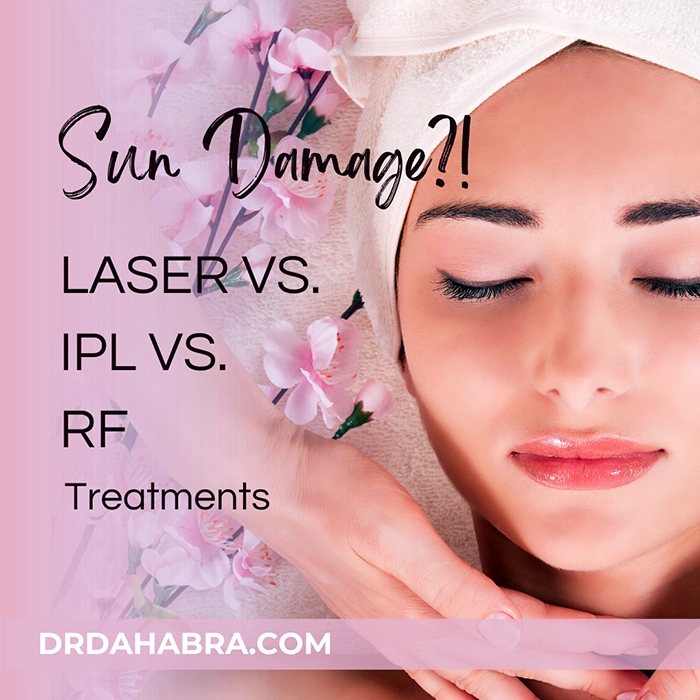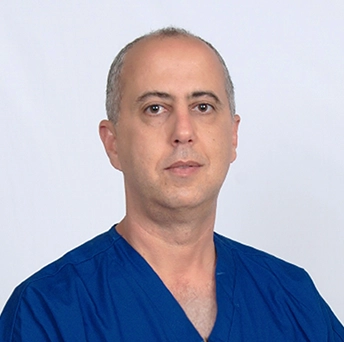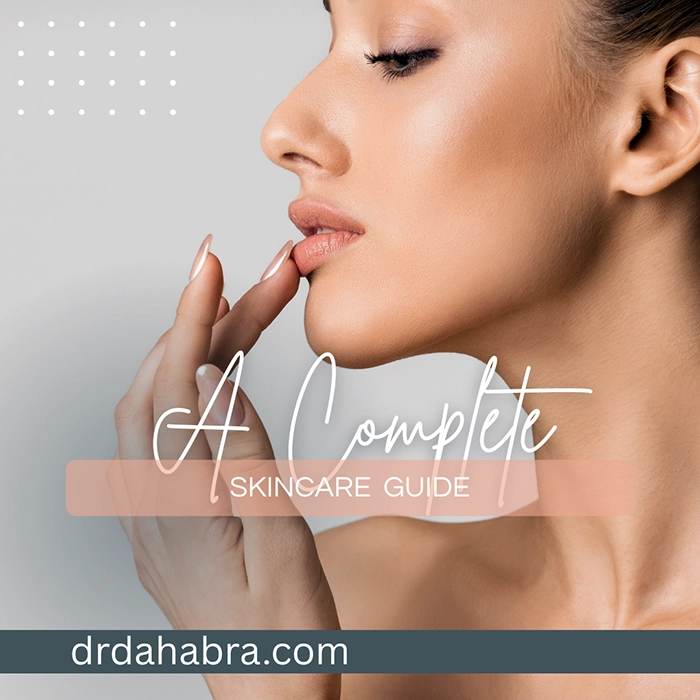Outsmart Sun Damage: The Latest Lasers, IPL, and RF Treatments Explained
Ready to reverse sun damage, how can the latest laser, IPL, and RF treatments help?
Picture your skin as a canvas marred by UV-induced mishaps, sunspots, uneven tone, and fine lines. This article is about Laser vs. IPL vs. RF: A Definitive Guide to Erasing Sun Damage.
Traditional fixes can barely scratch the surface. But our expert guide dives into the latest laser sun spot removal, IPL for sun spots, and radiofrequency skin tightening.
You’ll see how each treatment, from Fraxel laser resurfacing and CO2 laser for sun damage to Sylfirm X for photoaging and IPL
Laser targets different layers and concerns. Lasers deliver a single, focused wavelength to target pigmentation or texture issues precisely.
IPL for pigmentation, also known as a BBL photofacial, utilizes a broad spectrum that treats redness and sun damage over a wider area, but may require more sessions. Radiofrequency (RF) uses heat, not light, to stimulate collagen, making it color-blind and safe for all skin types, particularly helpful in addressing skin laxity.
Treatments like RF microneedling combine precision with collagen stimulation. Think of it as customizing the perfect treatment cocktail to remove sun damage and rejuvenate your skin.
Whether you’re targeting sun damage on your chest, hands, or cara, this guide helps you make the most informed decision.
Índice
1. What is the difference between sun damage and photoaging?
2. How does sun damage actually affect my skin?
3. Why are traditional topical creams not enough to reverse sun damage?
4. How do laser treatments work to correct sun damage?
5. Is IPL a laser, and how does it work to treat brown spots and redness?
6. How does Intense Pulsed Light (IPL) target multiple skin concerns at once?
7. How is radiofrequency (RF) different from light-based treatments?
8. How does RF energy help with skin laxity and wrinkles caused by sun damage?
9. What is RF microneedling, and why is it a powerful combination therapy?
10. What is the most effective treatment for hyperpigmentation and brown spots?
11. What is the ideal treatment for fine lines and wrinkles from sun exposure?
12. How do I choose between a laser, IPL, or RF treatment?
13. What do dermatologists vs. estheticians recommend for sun damage?
14. How do combination treatments (IPL + RF or Laser + RF) compare to single options?
15. Preguntas más frecuentes (FAQ)
16. Conclusión
17. Referencias
1. What is the difference between sun damage and photoaging?
Sun damage refers to the physical effects of ultraviolet (UV) rays, such as pigmentation issues like sunspots, hyperpigmentation, broken capillaries, and surface roughness, on areas like the chest and hands.
Photoaging, on the other hand, is a broader term for cumulative UV-related aging, characterized by fine lines, wrinkles, collagen breakdown, sagging, and deeper skin laxity. While sun damage primarily affects pigmentation and texture, photoaging encompasses the entire aging process.
You may develop sunspots or brown freckles from sun exposure today, and over the years, develop wrinkles or an uneven tone from photoaging. Understanding both helps you target treatments, such as LaserLaser for pigmentation, RF for skin tightening, and combinations for comprehensive correction.
2. How does sun damage actually affect my skin?
Imagine UV rays as microscopic saboteurs.
They penetrate your skin, leading to melanin overproduction and the formation of brown sun spots, freckles, and widespread hyperpigmentation. Beneath the surface, UV destroys collagen and elastin fibers, causing saggy skin, fine lines, and overall laxity.
Blood vessels can also dilate or break, causing redness or telangiectasia. Over time, sun-exposed areas, especially the chest and hands, begin to show more pronounced texture changes, pigmentation, and even precancerous lesions.
It’s why treating sun damage isn’t just cosmetic; it’s helping skin regain its natural structure, tone, and protective function.
3. Why are traditional topical creams not enough to reverse sun damage?
Topical creams, such as retinoids, antioxidants, and brightening agents, are like gentle surface scrubs.
They help maintain skin and slow future damage, but don’t undo deeper issues. They can lighten sun damage on hands and chest incrementally, but not erase embedded sun spots or reverse collagen loss.
Lasers, IPL, and RF go deeper. For example, a CO2 laser for sun damage or Fraxel laser resurfacing penetrates the dermis to stimulate collagen, while IPL for freckles removal or brown spots provides pigment breakdown.
Topicals help support results, such as post-laser sun care tips, but alone, they can’t rebuild or resurface skin the way professional sun damage treatment tools can.
4. How do laser treatments work to correct sun damage?
Lasers work by emitting a single wavelength of light that precisely targets chromophores, like melanin in brown spots or water in skin cells.
Fractional laser treatments, such as Fraxel, CO2 laser, and Erbium laser, create micro-injuries to stimulate collagen and resurface the skin. CO2 laser for sun damage is potent for deep texture and wrinkles, while Erbium laser treatment offers more controlled resurfacing with less downtime.
Picosecond laser sunspots deliver ultra-short pulses to shatter pigment, minimizing heat damage. AI skin treatment laser systems can even adapt in real time.
And low-downtime sun damage treatments, such as IPL Laser, offer a glow with minimal recovery time. After treatment, your body naturally sheds damaged tissue and replaces it with radiant new skin.
Recovery time varies; CO2 lasers might require 1–2 weeks, while non-ablative lasers may need less.
5. Is IPL a laser, and how does it work to treat brown spots and redness?
IPL (Intense Pulsed Light) is not technically a laser; it uses broad-spectrum light (typically 500–1200 nm), not a single wavelength.
That makes it versatile for treating brown sun spots, broken capillaries, redness, and uneven skin tone. The light is absorbed by melanin and hemoglobin, which heat and breaks them apart.
Over the next few days, pigment rises and flakes off. Treatments like BBL photofacial are advanced versions of IPL with higher precision.
IPL for pigmentation delivers skin rejuvenation, effectively treating sun damage across larger areas. While lasers like Fraxel target deep spots precisely, IPL covers broader issues with gentler energy.
Most people need 3–6 sessions for good results.
6. How does Intense Pulsed Light (IPL) target multiple skin concerns at once?
IPL is like a Swiss Army knife.
Its broad-spectrum pulses are absorbed by different chromophores: melanin in pigmented spots, hemoglobin in redness, and broken vessels. You can fade freckles, sun damage, and brown spots, as well as address redness and broken capillaries, all in one treatment.
It also stimulates collagen to smooth fine lines and improve texture subtly. That’s why it works for treating sun damage across multiple concerns, especially for fairly resilient skin types (Fitzpatrick I–III), though caution is required for darker complexions.
7. How is radiofrequency (RF) different from light-based treatments?
RF uses electrical energy to deliver heat into the dermis, but it’s color-blind, meaning it doesn’t target melanin.
That makes it safe for all skin tones, even those with deeper tones, unlike many lasers or IPL treatments that risk hyperpigmentation. The heat disrupts old collagen fibers and triggers the formation of new collagen, improving laxity, smoothing fine lines, and providing a mild lifting effect.
RF microneedling adds precision by combining tiny needles that deliver RF energy deeper into the skin, offering both resurfacing and tightening in one go.
8. How does RF energy help with skin laxity and wrinkles caused by sun damage?
RF heat stimulates fibroblasts in the dermis to produce new collagen and elastin, thereby firming the skin and reducing wrinkles, even in sun-damaged areas such as the chest or face.
Over time, the tightening effect can make fine lines appear softer and the skin texture appear smoother.
RF is also gentler than ablative lasers, with less downtime and fewer risks of discoloration, making it essential for treating sun damage on hands or in darker skin tones and combining RF with microneedling targets both resurfacing and tightening, making it an ideal alternative for those seeking anti-aging laser options with fewer risks and side effects.
9. What is RF microneedling, and why is it a powerful combination therapy?
RF microneedling, similar to Morpheus8 for photoaging, utilizes tiny needles to deliver radiofrequency energy directly into the deeper layers of the skin.
This creates controlled micro-injuries and heat in the dermis, stimulating the production of collagen and elastin while resurfacing the skin simultaneously. It works on texture, wrinkles, and sagging in a single session and is effective in addressing sun damage on the face, chest, and hands.
And because RF is color-blind, it’s safer across all skin types. It’s a powerful combination of laser-like resurfacing with RF tightening, ideal for treating and correcting sun damage, and providing professional sun damage treatment with dramatic skin rejuvenation.
10. Which treatment is best for hyperpigmentation and brown spots?
For hyperpigmentation and brown spots (including sunspots, freckles, and pigmentation), IPL (especially Palomar Icon IPL photofacial) offers broad efficacy with minimal downtime.
CO2 laser for sun damage and Erbium laser treatment deliver stronger resurfacing, ideal for severe spots and texture issues. Picosecond laser sunspots are ideal for breaking down pigment with minimal downtime.
Your choice depends on the severity, skin type, and tolerance to downtime.
11. What is the ideal treatment for fine lines and wrinkles from sun exposure?
Fine lines and photoaging benefit from fractional laser resurfacing (Fraxel, CO2, Erbium), which stimulates deep collagen remodeling.
CO2 laser targets fine lines and sun damage texture with minimal downtime. Non-ablative lasers, such as the Palomar Icon (utilizing fractional technology), offer effective wrinkle smoothing with reduced healing time.
Sylfirm X RF microneedling tightens deeply, too, especially when wrinkles are accompanied by sagging. IPL can help soften shallow lines through collagen stimulation, but more dramatic wrinkle reduction is achieved with lasers or RF treatments.
12. How do I choose between a laser, IPL, or RF treatment?
It depends on your skin tone, the type of damage, your tolerance for downtime, and your goals.
IPL (skin rejuvenation) and photofacial treatments are ideal for addressing sun spots, freckles, redness, and uneven tone, and are best suited for lighter skin types (Fitzpatrick I–III), with minimal recovery time and requiring multiple sessions.
Lasers, ranging from non-ablative to ablative, are more powerful.Fraxel is suitable for deeper resurfacing, and CO2 is effective for dramatic results but requires longer recovery, making it great for addressing texture, wrinkles, and sunspots.
RF (especially RF microneedling, such as Sylfirm X) is best for tightening, is color-blind, and is safe for all skin types, with moderate downtime. A dermatologist consultation is key to tailoring the right laser vs. IPL for pigmentation and finding the optimal combination for your needs.
13. What do dermatologists vs. estheticians recommend for sun damage?
Dermatologists often recommend medical-grade approaches, such as ablative or fractional lasers (CO2, Fraxel, Erbium), or picosecond lasers, especially for deeper sun damage or fair skin.
These treatments are sometimes combined with topical tretinoin before/after (see your provider) to boost results. Estheticians may recommend gentler options, such as IPL for maintenance and tone improvement with minimal downtime.
RF microneedling is often offered by both, as they appreciate its safety across various skin tones. Always ensure that you receive proper training and verification when choosing a treatment provider.
14. How do combination treatments (IPL + RF or Laser + RF) compare to single options?
Combining treatments targets both pigment and laxity. For example, IPL fades sunspots and redness, while RF tightens and improves texture.
An IPL + RF combination can deliver surface correction and deeper collagen remodeling. Similarly, LaserLaser + RF, such as Fraxel plus RF microneedling, provides aggressive resurfacing with added lifting and firmness.
Clinicians often combine BBL photofacial (advanced IPL) with RF microneedling for comprehensive rejuvenation.
Combination approaches require fewer overall treatments, can reduce downtime compared to multiple single sessions, and address sun damage, uneven tone, wrinkles, and laxity all in one protocol.
15. Frequently Asked Questions (FAQs) about Laser vs. IPL vs. RF: A Definitive Guide to Erasing Sun Damage
Q1. Can RF treatments be used safely on all skin types?
Respuesta concisa: Yes, RF treatments are color-blind and safe for all skin types.
Respuesta detallada: RF energy does not rely on melanin to produce its results, making it a safe and effective method for even the deepest skin tones.
This avoids risks such as hyperpigmentation associated with light-based therapies, allowing for sun damage chest laser treatment or RF microneedling on all complexions without fear of color-related side effects.
Q2. Are these treatments painful, and what is the typical downtime?
Respuesta concisa: Sensations vary; lasers may feel hot or prickly; IPL and RF are more comfortable, and downtime spans from hours to up to two weeks, depending on treatment.
Respuesta detallada: IPL often causes mild warmth or snapping sensations, accompanied by redness that lasts for several hours. Non-ablative lasers and RF have minimal downtime.
Ablative treatments, such as CO2 or Fraxel, may cause peeling and redness and require one to two weeks of healing. Comfort levels and recovery depend on the device and energy used, and providers offer cooling and numbing options.
Q3. What kind of results can I realistically expect from these procedures?
Respuesta concisa: Expect a smoother tone, reduced sunspots, and tighter skin. Significant changes often emerge after a series of sessions and proper aftercare.
Respuesta detallada: IPL can reduce up to 70–75% of brown spots and redness. Fractional lasers deliver better wrinkle and texture improvements (up to ~72%). RF microneedling tightens skin and improves laxity.
Results build over weeks to months, and consistent use of sunscreen preserves these benefits. Individual outcomes depend on the severity of the condition and the treatment plan.
Q4. How many sessions will I need to see a significant improvement?
Respuesta concisa: Typically 3–6 IPL sessions, or 3–5 sessions for fractional lasers or RF microneedling.
Respuesta detallada: IPL often needs 3–6 spaced weeks apart to fade sunspots, redness, and even tone. Non-ablative lasers, such as those at 1540 nm, typically require 3–5 treatments for visible improvement.
Ablative lasers may deliver more dramatic results, sometimes in fewer sessions, but with a more prolonged recovery period. RF microneedling typically requires 3–5 sessions in total.
Q5. What should my post-treatment rutina de cuidado de la piel look like?
Respuesta concisa: Gentle cleansing, intensive moisturization, and high SPF protection. Avoid activities until skin heals.
Respuesta detallada: Begin with a gentle, soothing cleanser and follow with a hydrating moisturizer. Use SPF 30+ daily to protect your fragile, post-treatment skin.
Avoid using retinoids, acids, or exfoliants during the healing process. Follow your provider’s post-laser or IPL aftercare instructions to minimize scabbing and promote recovery.
Q6. How can I prevent new sun damage after my treatments?
Respuesta concisa: Daily SPF use, sun avoidance, protective clothing, and regular touch-ups help sustain results.
Respuesta detallada: UV exposure is the primary cause of new sunspots and photoaging. Use broad-spectrum SPF daily, wear hats and UPF clothing, and avoid peak sun hours.
Scheduling regular maintenance treatments, such as IPL or non-ablative laser sessions, can help maintain precise, youthful results.
Q7. What are the most common risks and side effects?
Respuesta concisa: Redness, swelling, pigment change, or scabbing, more intense with ablative lasers, especially on dark skin.
Respuesta detallada: IPL and non-ablative tools may cause temporary redness or changes in pigment. Ablative lasers, such as CO2, can lead to peeling, infection, or prolonged redness if not correctly managed.
Individuals with dark skin tones have a higher risk of hyperpigmentation or hypopigmentation, so patch testing and selecting the appropriate device (such as RF or Nd: YAG lasers) are crucial.
Q8. Why is a consultation with a dermatologist so crucial?
Respuesta concisa: Because they tailor treatment to your skin type, coordinate safety (especially for dark skin), and design your recovery.
Respuesta detallada: A board-certified dermatologist can assess your Fitzpatrick skin type, damage severity, and guide between options, IPL vs Laser vs CO2, while avoiding risks. For example, individuals with darker skin may not tolerate IPL well, requiring alternatives such as Nd: YAG or RF microneedling.
They also manage pretreatment, post-treatment care, and optimize results with medical-grade cuidado de la piel.
Q9. How do these in‑office treatments compare to at‑home devices?
Respuesta concisa: At‑home IPL/laser tools are gentler, less effective, and require consistent use; professional treatments give stronger, longer-lasting results safely.
Respuesta detallada: Home devices offer maintenance-level improvements, but progress is slow. They’re lower in energy, lower in risk, but also lower in results.
In-office treatments utilize medical-grade technology and expertise to achieve more dramatic, controlled outcomes with enhanced safety and efficacy. For the removal of sun damage, only professional options are reliably effective.
Q10. Can these treatments also help with precancerous spots?
Respuesta concisa: They may improve appearance, but true precancerous spots need medical evaluation, not just cosmetic treatment.
Respuesta detallada: While lasers like CO2, Erbium, or IPL can fade actinic keratoses (precancerous spots), you need a medical diagnosis. Some lesions require biopsy or field treatments with topical drugs or photodynamic therapy.
Cosmetic devices shouldn’t replace medical care for these conditions; consult a dermatologist first.
Q11. How can I maintain my results for years to come?
Respuesta concisa: Regular sunscreen, maintenance treatments, and good skincare routines are key.
Respuesta detallada: Results last longer with daily use of broad-spectrum SPF and antioxidant-rich moisturizers, along with periodic touch-ups (every 6–12 months).
Non‑ablative lasers, IPL, or RF boosters can help sustain collagen and pigment control.
Q12. Did laser treatment make my melasma worse?
Respuesta concisa: It can; melasma is sensitive to heat and light; improper laser choice may exacerbate it.
Respuesta detallada: Melasma often reacts negatively to aggressive laser treatments or IPL, especially in individuals with darker skin. It can flare or darken post-treatment.
That’s why providers approach melasma cautiously, using low-fluence lasers, pigment-friendly devices like pico lasers, or combining with topical stabilizers. A tailored approach is essential.
Q13. How long does it take for the brown spots to flake off after an IPL treatment?
Respuesta concisa: Usually within 3–10 days, spots darken then slough away, revealing clearer skin.
Respuesta detallada: After IPL treatment, pigmentation may darken or appear crusty for a few days, then gently flake off within 3–10 days. Gentle skincare and sun avoidance during this time help ensure smooth shedding.
Q14. Is it normal to have a ‘coffee ground’ texture after a fractional laser?
Respuesta concisa: Yes, that’s normal. Tiny dark speckles are micro‑crusts and typically fall off in a few days.
Respuesta detallada: After fractional Laser Treatment (like Fraxel or CO2), you may notice pinpoint dark areas resembling coffee grounds. These are superficial micro-crusts from tiny treatment zones.
They fall away naturally within about 3–5 days, revealing fresh, healthy skin beneath. Avoid picking to prevent scarring.
Q15. What’s the best treatment for sun damage on my hands and chest?
Respuesta concisa: CO2 or fractional lasers for deep correction; IPL or RF microneedling for gentler surface rejuvenation.
Respuesta detallada: The chest and hands often show stubborn sun damage. Fractional CO2, Fraxel, or Erbium laser delivers powerful resurfacing to improve pigmentation, texture, and wrinkles.
If you want less downtime, IPL for sunspots or RF microneedling offers rejuvenation with a moderate recovery period. A combination of maintenance plans ensures long-term results while treating sensitivity in these delicate areas.
16. Conclusion: Laser vs. IPL vs. RF: A Definitive Guide to Erasing Sun Damage
Reclaiming your skin’s youthful radiance is about more than just chasing estética trends; it’s about outsmarting the sun’s lasting impact.
Whether you’re frustrated by sun damage on your chest, fine lines etched from years of photoaging, or uneven hyperpigmentation on your hands, this guide has shown how modern laser sun spot removal, IPL, and radiofrequency skin tightening can deliver fundamental, lasting transformation.
These advanced professional sun damage treatments, from CO2 laser for sun damage to low-downtime options like IPL Laser and powerful RF microneedling (Sylfirm X for photoaging), offer hope for brighter, firmer, more confident skin.
What’s truly empowering is knowing the right tool exists for every unique skin story. IPL gently fades sunspots, redness, and freckles, while lasers like Fraxel and Erbium rebuild texture from within.
RF energizes collagen without bias toward skin tone. Combine them, and you’ve got a custom blend that waves goodbye to pigmentation, sagging, and dullness all at once.
This isn’t just about erasing the past; it’s about inviting back your luminosity, confidence, and the glow you thought was gone.
All it takes is that first step: a thoughtful consultation with a trusted professional.
With tailored protocols, competent post-treatment care, and fearless sun protection, you can achieve radiant skin that not only resists aging but also turns back the clock.
Your skin deserves a second chance. Let these powerful, laser-focused treatments deliver it.
We have covered everything about Laser vs. IPL vs. RF: A Definitive Guide to Erasing Sun Damage.
Laser vs. IPL vs. RF: A Definitive Guide to Erasing Sun Damage
A definitive guide to erasing sun damage with Dr. Dahabra. ¿A qué esperas para liberar tu belleza?
Llámenos ahora al (954) 595-2607 o reserve online. Su viaje comienza con sólo un clic o una llamada.
Abraza la belleza, abraza la innovación - Embrace You.
17. Referencias
Beverly Hills Wellness Center & Med Spa, Florida
Treatment of Solar Lentigines: A Systematic Review of Clinical Trials
PMC / Institutos Nacionales de Salud
A review evaluating IPL and various laser modalities (like picosecond Nd: YAG) for treating solar lentigines (sun spots), reporting high pigment reduction rates (~74%) and favorable safety profiles.
Radiofrequency facial rejuvenation: Evidence‑based effect
PMC / Institutos Nacionales de Salud
Explores how RF treatments remodel sun‑damaged dermis by breaking down abnormal elastotic material and stimulating collagen formation, improving skin texture and appearance.
Efficacy of fractional Laser, radiofrequency, and IPL rejuvenation of the periorbital region
PMC / Institutos Nacionales de Salud
Compares non‑ablative fractional laser, bipolar RF, and IPL in treating aging around the eyes. Laser yielded the most notable improvement in elasticity, but all treatments enhanced skin firmness and reduced wrinkles.
OAText (Open Access journal)
A clinical trial has shown that combined RF + IPL (elōs Plus) is more effective than IPL alone in improving texture, pigmentation (solar lentigines), and laxity on the hands, with minimal downtime.
Current Trends in Intense Pulsed Light
PMC / Institutos Nacionales de Salud
A broad overview of IPL applications in treating vascular and pigmented lesions, photoaging, rosacea, and actinic keratoses—highlighting expanding clinical indications and evolving IPL technology.
Lasers and intense pulsed light (IPL) are associated with cancerous lesions
PubMed (Springer review)
A 25-year review confirms that lasers and IPL have not been shown to increase the risk of skin cancer; in fact, resurfacing can potentially prevent certain UV-induced tumors.
Carcinogenesis related to intense pulsed light and UV exposure
PubMed / National Institutes of Health
An animal study indicated IPL alone did not induce tumors or heighten UV-induced cancer risk, though UV exposure before or after IPL affected side effects.
Unlocking the Power of Light on the Skin: A Comprehensive Review
MDPI International Journal of Molecular Sciences
A narrative review examining photobiomodulation, low-level laser therapy, and LED in dermatologic applications, outlining mechanisms, clinical efficacy, and technological advances.
Advancements in laser technologies for skin rejuvenation
Wiley Journal of Cosmetic Dermatology
A recent (2024) review discussing modern laser systems that even out tone and reduce the visible signs of sun damage, supporting their efficacy in treating photoaged skin.
Revisiting Unaddressed Safety Concerns Regarding IPL Treatment
Wiley Photodermatology, Photoimmunology & Photomedicine
A safety-focused article examining the potential adverse outcomes of IPL, including cellular senescence or photocarcinogenesis, when treatments are administered improperly, and advocating for cautious practice.




